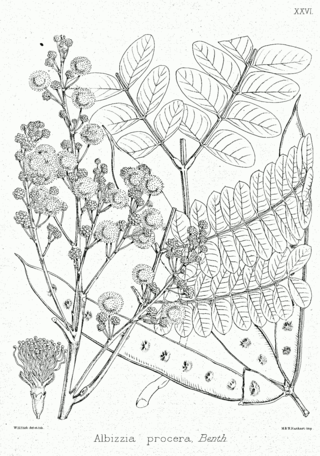
Agave americana, commonly known as the century plant, maguey, or American aloe, is a flowering plant species belonging to the family Asparagaceae. It is native to Mexico and the United States, specifically Texas. This plant is widely cultivated worldwide for its ornamental value and has become naturalized in various regions, including Southern California, the West Indies, South America, the Mediterranean Basin, Africa, the Canary Islands, India, China, Thailand, and Australia.
Spondianthus is a genus of plant, in the family Phyllanthaceae and is the only genus comprised in the tribe Spondiantheae. It was first described as a genus in 1905. The genus contains only one recognized species, Spondianthus preussii, widespread across much of tropical Africa from Liberia to Mozambique.
- Spondianthus preussii subsp. glaber(Engl.) J.Léonard & Nkounkou – from Nigeria to Tanzania south to Angola; also Guinea, Ivory Coast
- Spondianthus preussii subsp. preussii – from Liberia to Zaire

Dipteryx is a genus containing a number of species of large trees and possibly shrubs. It belongs to the "papilionoid" subfamily – Faboideae – of the family Fabaceae. This genus is native to South and Central America and the Caribbean. Formerly, the related genus Taralea was included in Dipteryx.

Leucaena is a genus of flowering plants in the mimosoid clade of the subfamily Caesalpinioideae of the family Fabaceae. It contains about 24 species of trees and shrubs, which are commonly known as leadtrees. They are native to the Americas, ranging from Texas in the United States south to Peru. The generic name is derived from the Greek word λευκός (leukos), meaning "white," referring to the flowers.

Kirkia is a genus of plant in family Kirkiaceae. It was previously placed in family Simaroubaceae, but was transferred into Kirkiaceae, together with Pleiokirkia, because these genera produce neither quassinoids nor limonoids.

Wissadula is a genus of flowering plants in the mallow family, Malvaceae. It contains 25 to 30 species of herbs and subshrubs that are mostly native to the Neotropics, with several in tropical Asia and Africa. The name is derived from the Sinhala language.
Dioclea guianensis is a species of legume native to the Americas.

Dicymbe is a genus of 20 species of canopy trees in the family Fabaceae, within subfamily Detarioideae. It is found throughout the Guyana Shield region and parts of W Amazonia. Certain species within the genus are strongly associated with ectomycorrhizal fungi.

The Anhui musk deer is an endangered species of musk deer that is endemic to the Dabie Mountains of western Anhui province, China. It was formerly described as a subspecies of Moschus berezovskii and Moschus moschiferus, but is now classified as a separate species.
Strobilanthes japonica is a flowering herbaceous perennial plant from Asia, one of around 350 plants of the genus Strobilanthes. The 20–50 cm ornamental plant is cultivated in Japan and China, and blooms in autumn with 1.5 cm purple to white funnel-shaped flowers.

Magnolia liliifera, commonly known as egg magnolia, is a flowering tree native to the Indomalayan realm. It bears white to cream-colored flowers on terminal stems. The leaves are elliptical and get as large as 25 cm (10 in) long and 8 cm (3 in) wide. The tree ranges in height from 3.5 to 18.5 m in situ.

Maundia is a genus of alismatid monocots, described in 1858. Maundia was formerly included in the family Juncaginaceae but is now considered to form a family of its own under the name Maundiaceae. It contains only one known species, Maundia triglochinoides, endemic to Australia.

Anastrabe is a genus of flowering plants in the family Stilbaceae described as a genus in 1836.
Burmannia grandiflora is a flowering plant in the family Burmanniaceae found in Colombia, central Brazil, and Bolivia. It grows mostly on wet savannas, sandy soil, from sea level to a height of 1230 meters.
Dioscorea orizabensis is a species of yam in the family Dioscoreaceae. It is native to the Jalisco and Veracruz states of Mexico. The plant is a climbing tuberous geophyte which grows in mountain forests.
Dioscorea ovinala is a species of yam in the family Dioscoreaceae. It is endemic to Madagascar and grows mostly in dry deciduous forests.
Dioscorea stipulosa is a type of climbing tuberous geophyte of the family Dioscoreaceae. It is endemic to the Eastern Cape province of South Africa.

Albizia procera, commonly known as white siris or karoi tree, is a species of large tree found natively in southeast Asia and India. It is most commonly found in open forests, but may also be found on the margins of rain forests and in monsoon and gallery forests. It is considered an invasive species in South Africa.
Inga striata is a perennial tree species and is a member of the family Fabaceae. This species occurs in countries like Bolivia, Brazil, Colombia, Ecuador, Guyana, Peru, Suriname and the territory of French Guiana.











